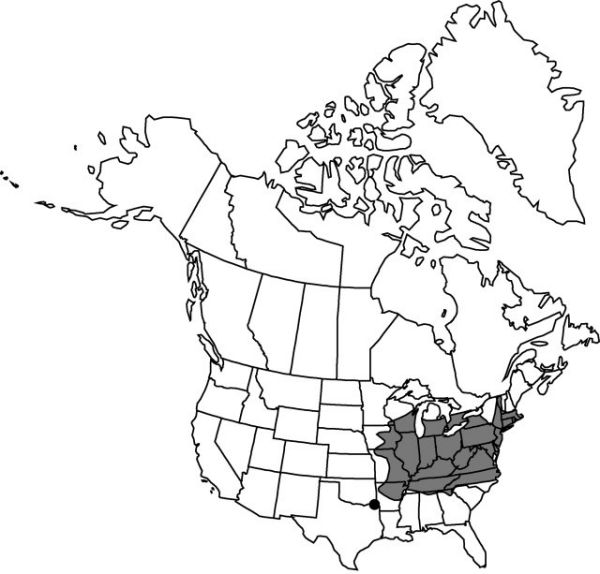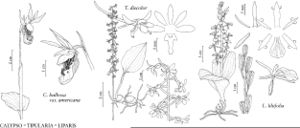Liparis liliifolia
Bot. Reg. 11: plate 882. 1825.
Plants 9–25 cm. Pseudobulbs ovoid, 20 ×10 mm, sheathed by bracts and persistent leaf-bases, previous year’s pseudobulb usually present, connected by short rhizome. Stems bright green, with or without purplish brown tinge, angled, sometimes obscurely winged or fluted distally. Leaves 2; blade conduplicate, dark green, glossy, ovate-elliptic, keeled abaxially, 4–18 × 2–8.5 cm, succulent, apex obtuse to acute. Inflorescences 4–15 cm; floral bracts subulate, 2 × 1 mm, apex acute; pedicels slender, 5–7 mm. Flowers 5–31, mauve-purple and green; dorsal sepal oblong-lanceolate to narrowly lanceolate, 8–11.5 × 1.2–2 mm, apex obtuse to acute; lateral sepals oblong-lanceolate to narrowly lanceolate, 8–11.5 × 1.2–2 mm, apex obtuse to acute; petals pendent, curved, tubular, narrowly linear to filiform, 8.5–12 × 0.2–0.3 mm, margins strongly revolute; lip translucent, mauve to pale-purple or rarely green with prominent purplish veining, cuneate-obovate to suborbiculate, 8–12 × 6–10 mm, base slightly auriculate, apical margin erose-serrulate, apex subtruncate, mucronate; column winged apically, 3–4 × 1–1.5 mm, with 2 blunt tubercles on inner surface near base; anthers yellow; pollinia yellow. Capsules: pedicel 11–18 mm; body ellipsoid, 15 × 5 mm, veins often slightly winged.
Phenology: Flowering May–Jul (north).
Habitat: Mature mesic to moist deciduous forests, pine woods, rich moist humus, often colonizing previously open, disturbed habitats during early and middle stages of reforestation
Elevation: 10–1500 m
Distribution

Ont., Ala., Ark., Conn., Del., Ga., Ill., Ind., Iowa, Ky., Md., Mass., Minn., Miss., Mo., N.H., N.J., N.Y., N.C., Ohio, Okla., Pa., R.I., S.C., Tenn., Vt., Va., W.Va., Wis.
Discussion
Liparis liliifolia has what appear to be extremely similar relatives in Japan [L. japonica (Miquel) Maximowicz and L. makinoana Schlechter] and China (L. pauliana Handel-Mazzetti and L. cathcartii Hooker f.). Further work is needed to clarify the relationships among these five species. It could be a case of either divergent evolution from a common ancestor or convergent evolution from two or more ancestors.
Selected References
None.
